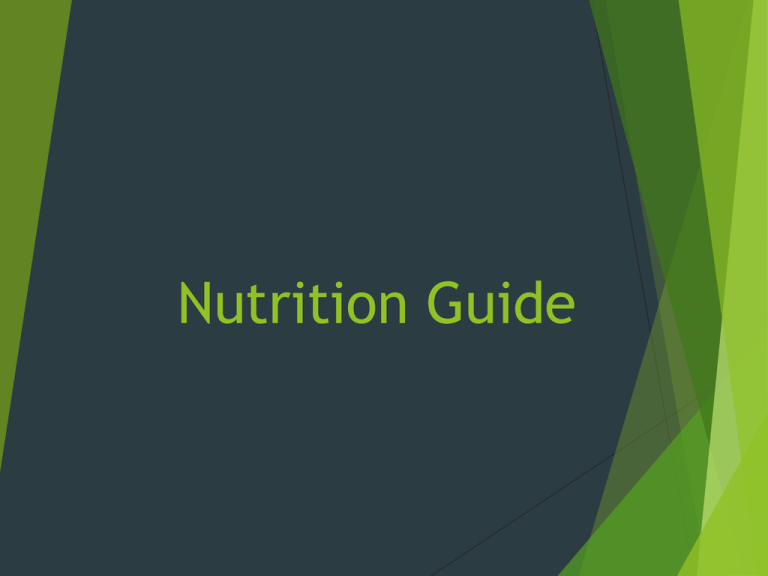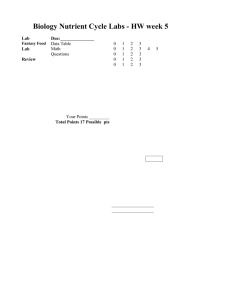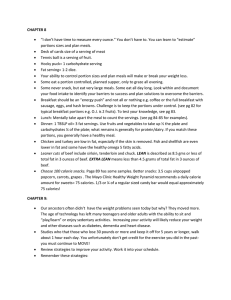Nutrition Guide
advertisement

Nutrition Guide Serving Size - Everyday examples can help you compare your portion size 1 cup green salad ................................................................ is a fist or a tennis ball 1 baked potato..................................................................... is a fist or a tennis ball ¾ cup tomato juice ............................................................. is a small Styrofoam cup ½ cup cooked broccoli........................................................ is a scoop of ice cream or a light bulb ½ cup serving........................................................................ is 6 asparagus spears/7 or 8 baby carrots/1 ear of corn The Fruit Group ½ cup of grapes (15 grapes)............................................. is a light bulb ½ cup of fresh fruit........................................................... is 7 cotton balls 1 medium size fruit ............................................................ is a fist or a tennis ball 1 cup of cut-up fruit .......................................................... is a fist or a tennis ball ¼ cup raisins......................................................................... is a large egg or a golf ball The Milk, Yogurt, and Cheese Group 1½ ounces cheese................................................................ is a 9-volt battery or your index and middle fingers 1 ounce of cheese ............................................................... is a pair of dice or your thumb 1 cup of ice cream .............................................................. is a large scoop the size of a tennis ball The Meat, Poultry, Fish, Dry Beans, Eggs, and Nuts Group Calories Calorie has become a household word, although exactly what a calorie does is a mystery to many. Ask one hundred people what a calorie is and most will tell you it is "the thing in food that makes me fat." Calories have gotten a bad reputation and are considered by many to be the enemy. Few people truly understand what a calorie is and why it is so important to their bodies. The important word to take away from this definition is ENERGY. Calories are ENERGY that fuel our bodies; much like gasoline fuels our cars. Without sufficient calories our heart would not beat, our lungs would not function, and our brain would not work. Many of us have no idea how many calories our body needs just to exist. If you exceed the number of calories your body requires each day you will eventually gain weight. It takes an excess of 3500 calories to gain 1 lb. of fat. For example, if your body needs 2000 calories a day to maintain its current weight and every day you consume 2500 (one 20 oz Mocha Swirl Latte could add 500 calories) in one week you would gain 1 lb. One day of overindulging does not cause instant weight gain. What makes a calorie 1g carbohydrate contains 4 calories. 1g protein contains 4 calories. 1g fat contains 9 calories. What makes a calorie 1g carbohydrate contains 3.75 calories. 1g protein contains 4 calories. 1g fat contains 9 calories. Calories from FAT Fat calories are calories of fat origin. Fats are food substances that the body needs to build its constituents. Fats are also used as body fuel to produce warmth. If fats are not burned for energy, they are accumulated in fat cells. Some people consume more fats than are needed for the body Saturated Fat and Trans Fat Saturated Fat - Like all fats, saturated fats are a source of fuel for the body, aid in absorption of fat-soluble vitamins, are used to build cell membranes, and hold other purposes. The human body can make all the saturated fat it needs. Trans fat is the common name for unsaturated fat with trans-isomer (E-isomer) fatty acid(s). The consumption of trans fats increases the risk of coronary heart disease[1][2] by raising levels of LDL cholesterol and lowering levels of "good" HDL cholesterol Cholesterol Lipids are fats that are found throughout the body. Cholesterol, a type of lipid, is found in foods from animal sources. This means that eggs, meats, and whole-fat dairy products (including milk, cheese, and ice cream) are loaded with cholesterol — and vegetables, fruits, and grains contain none. Because cholesterol can't travel alone through the bloodstream, it has to combine with certain proteins. These proteins act like trucks, picking up the cholesterol and transporting it to different parts of the body. When this happens, the cholesterol and protein form a lipoprotein together. HDL and LDL The two most important types of lipoproteins are highdensity lipoproteins (or HDL) and low-density lipoproteins (or LDL). You've probably heard people call LDL cholesterol "bad cholesterol" and HDL cholesterol "good cholesterol" because of their very different effects on the body. Most cholesterol is LDL cholesterol, and this is the kind that's most likely to clog the blood vessels, keeping blood from flowing through the body the way it should. On the other hand, HDL cholesterol removes cholesterol from the blood vessels and carries it back to the liver, where it can be processed and sent out of the body Sodium Sodium is salt. Our bodies need no more than 2400mg of sodium per day. 1 teaspoon of salt contains about 2400 mg of sodium Carbohydrates Carbohydrates are an ideal source of energy for the body. This is because they can be converted more readily into glucose, the form of sugar that's transported and used by the body, than proteins or fats can. There are two types of carbohydrate: complex and simple Complex carbohydrates as natural starches Simple carbohydrates are also known as sugars. They also exist in either a natural or refined form. Protein Protein is required by the body for the growth, maintenance and repair of all cells. Protein is a major component of all muscles, tissues and organs and is vital for practically every process that occurs within the body such as metabolism, digestion and the transportation of nutrients and oxygen in the blood.




